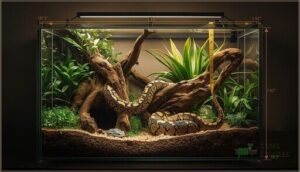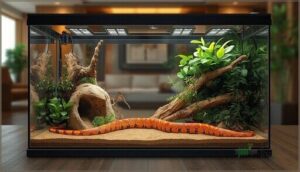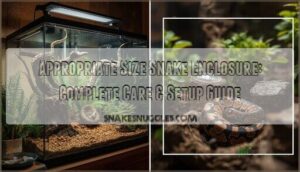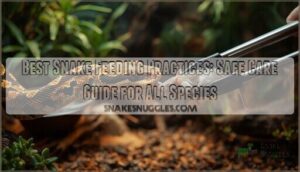This site is supported by our readers. We may earn a commission, at no cost to you, if you purchase through links.
A snake coiled tightly in the corner of its tank isn’t resting—it’s coping with chronic stress from cramped quarters. Many keepers unknowingly house their snakes in enclosures that look adequate but fall short of what these animals need for proper muscle development, thermoregulation, and mental well-being.
The difference between minimum survival space and ideal habitat size can determine whether your snake thrives or merely exists. Size requirements for snake habitat depend on species-specific behaviors, body length, and whether your snake prefers ground exploration or vertical climbing.
Getting the dimensions right from the start prevents health complications, reduces stress-related behaviors, and honors your responsibility as a keeper. Understanding the relationship between enclosure size and snake welfare sets the foundation for proper husbandry that fosters natural behaviors and long-term health.
Table Of Contents
Key Takeaways
- Snake enclosures must allow full body extension in length (minimum equal to the snake’s body length) to prevent stress, muscle atrophy, and behavioral issues that signal inadequate space.
- Species-specific requirements vary significantly—ball pythons need 8 square feet minimum for adults, corn snakes require 4’x2’x2′ dimensions, and arboreal species prioritize vertical space equal to or exceeding body length.
- Proper enclosure size enables essential thermal gradients (10-15°F difference between zones), humidity control (40-80% depending on species), and enrichment opportunities that reduce stress by 29% and increase activity time by 32%.
- Juvenile snakes actually need smaller starter enclosures to reduce stress and feeding refusal (which increases 30% in oversized tanks), with upgrades every 6-12 months as rapid growth demands larger dimensions.
Why Snake Habitat Size Matters
Your snake’s enclosure isn’t just a box—it’s the foundation of their entire world. Getting the size right sets up everything from proper temperature zones to natural movement patterns.
Getting it wrong, though, can lead to stress, health problems, and behaviors that signal something’s off.
Impact on Snake Health and Behavior
When your snake can’t fully stretch out, stress builds quietly but consistently. Enclosures matching or exceeding body length lessen stress and foster natural activity patterns like exploring and stretching. Restricted space triggers behavioral restriction and physical ailments tied to confinement.
Larger habitats improve welfare indicators—your snake moves more, uses hides actively, and shows fewer clinical health problems. Meeting environmental needs through adequate space directly underwrites long-term snake behavior and wellbeing. Ensuring adequate space is key, as research indicates improvements with larger enclosures.
Risks of Inadequate Enclosure Size
Cramped quarters invite serious trouble. When your snake lacks room to stretch, health consequences pile up fast—muscle atrophy, obesity, and weakened immunity make disease susceptibility climb.
Behavioral issues surface through aggression, escape attempts, and repetitive stress patterns. Injury risks rise as snakes scrape against walls or develop respiratory infections in poorly ventilated spaces.
Meeting species-specific requirements with proper enclosure size isn’t optional—it’s your snake’s lifeline against preventable suffering. Ensuring adequate space is vital for snake welfare, as seen in snake stretching needs.
Ethical Considerations in Snake Housing
Beyond health risks lies a deeper question: what do we owe our captive animals? Ethical standards in reptile welfare demand housing that honors natural behaviors, not just survival.
Responsible snake ownership means respecting animal rights through humane treatment—providing space for full extension, enrichment, and escape prevention. This isn’t sentimentality; it’s recognizing the ethical implications of keeping another creature dependent on your care.
Ethical snake ownership isn’t sentimentality—it’s honoring the welfare of a creature entirely dependent on your care
General Size Guidelines for Snake Enclosures
When you’re setting up a snake enclosure, you need to start with solid size calculations that work for your specific animal. The right dimensions depend on your snake’s length, activity level, and natural behavior patterns.
Let’s break down the core measurements and spatial considerations that will keep your snake healthy and comfortable.
Calculating Minimum Length, Width, and Height
Most experts agree your snake’s enclosure length should match or exceed its full body length—a standard backed by extension science.
Width calculation usually follows the formula of half your snake’s length, while height calculation runs 0.3 to 0.5 times that measure.
Calculating minimum size this way ensures proper floor dimensions, so your snake can stretch completely and move naturally.
Floor Space Vs. Vertical Space
When you refine your enclosure design, floor area matters most for terrestrial snakes—over 70% spend their time down low.
Arboreal species flip that script, using vertical space for climbing structures and escape routes. Studies show climbing success jumps to 87% when you add proper vertical exploration options.
Your floor dimensions anchor safety, but vertical space unleashes natural behavior in tree-dwelling species.
Importance of Allowing Full Body Extension
Your snake’s ability to stretch fully determines its welfare more than any other enclosure dimension. Scientific reviews confirm that snakes consistently adopt straight-line postures when given space—37% do this naturally.
Enclosures shorter than body length block normal locomotion and cause measurable stress. Full body extension in all directions isn’t optional; it’s the evidence-based minimum for species-specific requirements in any escape-proof enclosure.
Species-Specific Habitat Size Requirements
Different snake species have evolved in vastly different environments, which means their habitat requirements vary greatly. A ball python’s needs differ from those of a corn snake, and arboreal species require entirely different setups than terrestrial ones.
Let’s look at specific size requirements for some commonly kept species to help you create the right home for your snake.
Ball Python Enclosure Dimensions
Ball pythons grow predictably, and their enclosure size calculations should match that growth. Hatchlings under 300g need at least 20″ x 11″ x 13″, while juveniles under 3′ thrive in 36″ x 18″ x 18″ spaces. Adults over 3′ require 48″ x 24″ x 24″ minimum—roughly 8 square feet of floor area.
Snake length guidelines recommend your python can fully stretch, supporting both physical health and natural behavior patterns.
Corn Snake Habitat Size
Your corn snake needs room to roam—these active, curious serpents deserve better than cramped quarters. Adults commonly reach 3 to 5 feet and require enclosures where they can fully stretch their bodies straight across, not just diagonally.
Minimum enclosure size requirements:
- Floor dimensions: 4′ x 2′ x 2′ (120 x 60 x 60cm) for adults
- Species-specific calculation: snake length × half snake length × half snake length
- Escape-proof features: secure locks and sealed gaps (they’re escape artists)
- Thermal gradients and spatial complexity: larger habitats offer enhanced microclimate control
Small and Arboreal Snake Needs
Arboreal snake care demands thinking in three dimensions—vertical space matters as much as floor area. Green tree pythons and Amazon tree boas need enclosure heights matching or exceeding their body length, enabling natural climbing structures and perching behaviors.
| Snake Type | Height Minimum | Habitat Depth Focus |
|---|---|---|
| Arboreal species | ≥1× snake length | Vertical climbing zones |
| Small terrestrial | 0.5× snake length | Floor space priority |
| Juvenile arboreal | Equal to body length | Rectilinear stretching support |
| Tree-dwelling pythons | Exceeds body length | Perching branches required |
| Ground-dwelling small snakes | Standard 2′ (60cm) | Horizontal movement paths |
Small snake habitat requirements follow similar principles but scaled appropriately. Your escapeproof enclosure must accommodate growth, with regular reviews ensuring dimensions remain adequate as your snake matures.
Key Factors Influencing Enclosure Size
Choosing the right enclosure size isn’t just about measuring your snake’s length. You also need to think about how temperature zones, humidity levels, and enrichment features affect the space your snake actually needs.
These three factors work together to determine whether your enclosure is truly large enough for your snake to thrive.
Temperature Gradients and Zoning
Even if your enclosure’s spacious enough, poor temperature gradients can undermine your snake’s health. You need distinct warm and cool zones—ideally a 10–15°F difference—so your snake can regulate its body temperature naturally.
Position heating sources on one end only, covering no more than a third of the floor. Use digital probe thermometers to monitor both zones accurately and prevent digestive problems or stress.
Humidity Control and Ventilation
Once you’ve nailed temperature, humidity control and ventilation come next—they’re key to respiratory health and preventing shedding issues. Most species need 40–80% humidity, measured with a digital hygrometer at mid-level.
Balance is everything: too dry causes incomplete sheds, while poor ventilation brings mold. Position vents low on the cool side and high near heat to maintain airflow without losing moisture.
Enrichment, Hides, and Climbing Structures
Beyond climate control, your snake needs proper enrichment—hides, climbing structures, and varied decor stimulate natural behaviors and support cognitive health.
Multiple hiding spots reduce stress by 29%, while climbing benefits semi-arboreal species with 32% more activity time.
Enrichment variety matters: snakes in stimulating habitats develop 15% larger brain volumes and show fewer stereotypic behaviors. Behavioral impacts prove enrichment opportunities aren’t optional—they’re fundamental to wellbeing.
Tips for Selecting and Maintaining Proper Enclosures
Selecting the right enclosure isn’t just about size—it’s about creating a secure, maintainable environment that promotes your snake’s long-term health. You’ll need to think about factors like escape prevention, substrate management, and ongoing environmental monitoring to keep conditions stable.
Let’s walk through the essential elements you should evaluate when choosing and caring for your snake’s habitat.
Choosing Secure and Escape-Proof Habitats
Once you’ve sized your enclosure correctly, security becomes the next priority. Snakes are escape artists, and even small gaps can lead to a breakout.
- Material durability: PVC and acrylic resist warping better than glass tanks, which often develop gaps.
- Locking mechanisms: Use secure lid latches or wire locks—top-opening tanks account for most escapes.
- Ventilation safety: Cover all air ducts and vents with fine screening to prevent squeezing through.
Weekly inspection protocols catch worn seals early, keeping your design features escape-proof.
Substrate Selection and Maintenance
Your bedding material shapes the microclimate inside the enclosure. Coconut fiber and mulch maintain 27–33% better moisture retention than newspaper, helping species like ball pythons shed cleanly.
Avoid substrate contaminants—pesticide residues appear in 23% of non-certified products and can irritate skin. Aspen bedding works well for corn snakes, while monthly replacement frequency reduces bacterial buildup by 22%, keeping species suitability aligned with health outcomes.
Regular Cleaning and Environmental Monitoring
Consistent care logbooks reveal patterns others miss—temperature spikes, odor control lapses, or substrate breakdown. Your cleaning schedule directly impacts health outcomes:
- Daily spot cleaning removes waste and prevents bacterial buildup
- Weekly deep cleaning with safe cleaners like 3% bleach solution
- Monthly full sanitization for bioactive and standard setups
- Parameter monitoring tracks humidity levels and temperature zones
- Toxin monitoring ensures environmental control in urban areas
Document everything to maintain a truly clean habitat.
Frequently Asked Questions (FAQs)
Can multiple snakes share one enclosure safely?
Two heads aren’t better than one regarding snake housing. Most species shouldn’t cohabitate due to cohabitation risks, disease transmission, and resource competition.
Species compatibility matters—garter snakes tolerate multi-snake housing better than solitary species like ball pythons.
How often should I upgrade enclosure size?
You should upgrade your snake’s enclosure when its body length exceeds the tank’s longest dimension.
Juveniles with rapid growth rates often need upgrades every 6–12 months to prevent stress behaviors and health impacts.
What are signs my snake needs more space?
Watch for increased pacing, excessive hiding, reduced appetite, escape attempts, or aggression signs. These behaviors signal stress when your snake’s habitat no longer meets its growth needs, impacting wellbeing and requiring immediate spatial adjustments.
Do baby snakes need smaller starter enclosures?
Yes, baby snakes need smaller starter enclosures for stress reduction and security needs. Oversized tanks increase feeding refusal by 30%, while appropriately sized habitats improve growth rates and support species-specific requirements during early development.
Are glass or plastic enclosures better for snakes?
Both materials work well if you meet species-specific requirements for enclosure size and environmental control.
Glass terrariums offer better ventilation systems, while plastic/PVC enclosures excel at humidity control and escape-proofing measures, influencing snake behavior differently.
Conclusion
A ball python owner once upgraded from a 20-gallon tank to a 40-gallon breeder—and watched her snake’s refusal to eat vanish within two weeks. Space directly influences appetite, shedding quality, and immune response.
Meeting size requirements for snake habitat isn’t about luxury; it’s about preventing respiratory infections, skeletal deformities, and behavioral shutdown. Your enclosure dimensions determine whether your snake survives captivity or genuinely thrives in it. Choose wisely.
- https://www.petsmart.com/learning-center/reptile-care/snake-care-guide-how-to-take-care-of-a-pet-snake./A0042.html
- https://reptifiles.com/corn-snake-care-guide/corn-snake-terrarium-size/
- https://www.corhs.org/index.php?get=content&pageid=105
- https://www.youtube.com/watch?v=ajg5J0-r2Rw
- https://talis-us.com/blogs/news/optimal-enclosure-size-for-corn-snakes













